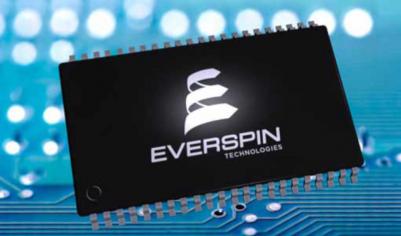Everspin Technologies is at the forefront of the MRAM industry, with a product range that spans Toggle MRAM and STT-MRAM, embedded MRAM IP, more. The company's president and CEO, Sanjeev Aggarwal, was kind enough to answer a few questions we had about the company, it's recent announcements and its future roadmap.
Thank you for your time Sanjeev, we appreciate it. A few days ago, Everspin announced it had received a strategic $14.55 million 2.5-year DoD project to provide continued and stable manufacturing services. Can you share more info? How will that money be allocated, and how will you ensure stable support?
Everspin has partnered with the DoD on various projects to deploy our MRAM technology and fab MRAM products for Defense Industrial Base customers in Chandler, Arizona. The award money will be used to strength the US MRAM manufacturing supply chain. Everspin will look at its supply chain and mitigate any risks identified. This can include second-sourcing gases and chemicals as well as upgrading processes.
Earlier in 2024 you announced that you applied for the CHIPS incentive program for expanded production capabilities. Is that a different project to the DoD one? Any updates on that?
The CHIPS incentive program is different from this award. This award is for strengthening our existing manufacturing facilities in Chandler, Arizona. This facility is used to produce Toggle MRAM products on 8-inch wafers and provide Toggle and STT-MRAM foundry services for our DoD customers.
Our application is active with the CHIPS Program Office (CPO) and we are waiting to hear back from them. If awarded, this would allow us to expand our production footprint in the US.
It seems as if radiation-hardened MRAM and space-grade MRAM is becoming more and more important for Everspin, with several new announcements including projects with Frontgrade and Quicklogic. Can you explain what radiation-hardened MRAM is, how it differs from your 'normal' products and what are your thoughts on this market segment?
MRAM is naturally immune to radiation damage up to strategic radiation levels (1 million Rad Si). However, the silicon circuits around the MRAM are susceptible to radiation, which need to be radiation-hardened for space-grade applications. A typical process flow for a radiation-hardened wafer with several devices would be for the DIB customer to build the radiation-hardened periphery in the silicon and ship these incomplete wafers to Everspin to build MRAM on them. Completed wafers with Everspin MRAM integrated into this silicon are then shipped back to the DIB customer for packaging and test.
There is no difference in Everspin's MRAM process between our commercial products and space grade products. The difference in the underlying silicon is described above. We believe this market segment is on the cusp of rapid growth with interest from deep space and low earth orbital (LEO) applications. Data logging and configuration memory that can perform in harsh environments is needed for this market segment and MRAM is the ideal choice. As customers realize the full potential of MRAM, we see our technology and products getting designed in at several customers.
In April 2024, Everspin rebranded its memory product family as PERSYST. Does that include both your Toggle and STT-MRAM product lines?
The PERSYST brand name is coined to convey superior Performance for Systems. Our MRAM enables a high-performance level, including data persistence, security, and low latency in harsh / extreme environments. These features are common to both our Toggle and STT-MRAM product lines, thus including them in the PERSYST family.
Everspin's discrete MRAM and STT-MRAM sales have been pretty stagnant in the last few years. How do you see the future, do you see a ramp-up in demand? What will trigger increased sales and production?
Everspin has reported four years of high single-digit CAGR growth in our sales from FY20 to FY23. In recent quarters, we have seen a reduction in orders as a result of an industry-wide slowdown in the industrial sector, combined with a build-up of inventory at our customers that is beginning to deplete. We expect normal production ordering to return and we are optimistic about a return to growth in the coming quarters. Triggers for increased sales are a recovery in APAC/Japan industrial markets, inventory levels returning to normal, and continued success in new design wins for our PERSYST family of products.
We know that researchers, and also some companies, are developing next-gen MRAM technologies, such as SOT-MRAM, pMTJs, and more. Is Everspin also working on next-generation material and process platforms? Can you share any details?
Everspin is actively developing new materials to improve the performance of our pMTJ-based STT-MRAM products. We do all our R&D in-house in our 8-inch FAB in Chandler, Arizona, thereby controlling costs and IP access. This development aims to successfully implement our roadmap for higher densities, different interfaces and cost reductions. We are constantly upgrading our process capabilities to stay on the cutting edge, which includes evaluating new technologies such as SOT-MRAM, VCMA, etc.
I am personally a shareholder in Everspin, what message do you wish to convey to investors in Everspin? How do you see the company in the next 5 years?
Everspin is strategically poised to address several memory markets. Last year, we commercialized low-density (64Mb and 16Mb) STT-MRAM families that extend our Toggle MRAM roadmap and address the data logging memory market, with an addressable TAM of ~ $400 million. In the next few years, we will introduce a high density (256Mb to 2Gb) xSPI STT-MRAM product that addresses the discrete NOR Flash memory market with a TAM of ~ $2.5 billion. MRAM is radiation-immune and ideally suited for Aerospace and Defense applications. We see significant traction with our DIB customers and expect these radiation-hardened products to add to our revenue streams.

We are a cutting-edge technology company with a demonstrated ability to successfully commercialize our technology. We are developing IP relevant to the storage and AI markets and plan to demonstrate this capability within the following year. We have been taking small and meaningful steps to revolutionize all aspects of the memory industry.
Thank you Sanjeev, for this interview. I wish both you and Everspin a good year ahead!




Comments
MRAM strategic radiation harness
In response to Ron Neale